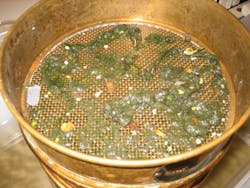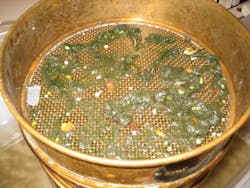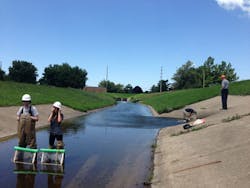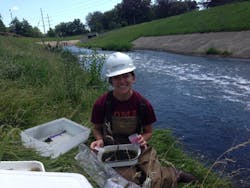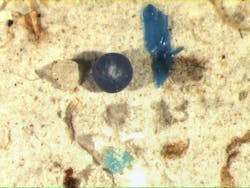Microplastics: A 'Tiny' Problem Needing a Massive Solution
Microplastics have emerged as a growing environmental threat but what specific problems do they cause for water and wastewater treatment plants? What developments can we expect over the next few years?
By Andrew Williams
In recent years, the dispersal of microplastics into global water sources has emerged as a significant and growing threat to the environment. Microplastics are generated by a wide variety of sources, including the tiny microbeads increasingly used in cosmetic and hygiene products like facial scrubs, toothpaste and beauty products. A recent study even suggests that more than 700,000 microscopic plastic fibres could be released into the environment during each cycle of a washing machine.
Impact on Aquatic Systems
The impacts of microplastics on aquatic ecosystems are diverse and wide ranging - and include negative effects for microbes, invertebrates, fish and other animals such as birds, turtles and marine mammals.
As Timothy Hoellein, associate professor of Biology at Loyola University Chicago, explains, the main concerns centre around ingestion by living creatures, which can cause animals to feel ‘full’. Therefore, they are less likely to eat the amount of food they need to stay alive - or cause internal damage. In addition, many kinds of microplastic have hydrophobic surfaces that adhere to common pollutants like polychlorinated biphenyls (PCBs).
“These chemicals would rather be ‘stuck’ to surfaces like plastic than in the water itself. If these compounds are highly concentrated on plastic, and then ingested by animals, the chemicals can desorb - become unstuck - in the low oxygen environment inside the gut. This could expose the animal to high concentrations of potentially toxic compounds,” says Hoellein.
The growing body of evidence relating to the potentially disastrous environmental impacts of microplastics has led to growing calls for a complete ban on their production and use in many products. Last year, the United Nations called for a complete worldwide ban on their use in cosmetics - and many individual countries have already taken concrete steps to address the problem.
For example, the US has enshrined a law banning their use from mid-2017 and, in September 2016, the UK government followed suit, announcing plans to ban microbeads from cosmetics by end of next year.
Urgent research needed
The sheer pace of legislative and policy changes such as these would indicate that, over the next decade or so, the writing is very much on the wall for the use of microplastics in many products. Even so, it still seems likely that the flow of microplastics and microbeads into the water supply is likely to continue in many regions for some time yet.
Moreover, as part of evidence recently collected by the UK government during an in-depth select committee investigation into the impacts of microplastics, Dr Erik van Sebille, an oceanographer and climate scientist at Imperial College London, highlighted the fact that plastics are ‘persistent contaminants’ - meaning that, even if it were feasible to put impose an immediate halt to the flow of plastic debris into the oceans, microplastic levels would continue to grow as a result of the fragmentation of bulkier items already loose in the environment.
In this light, van Sebille calls for urgent research to fully understand the “abundance, distribution and potential environmental impacts of microplastics” - as well as the potential solutions, some of which he points out are “already widely recognised”.
Role of treatment plants
In moving towards such solutions, it is likely that water and wastewater treatment plants will play a central role. That said, it is difficult to deny that many, if not most, of today’s facilities are simply not up to the task. Although many of the microplastics released into aquatic systems are captured by existing plants, the uncomfortable fact is that, depending on the degree of treatment, some microparticles still escape treatment and ultimately discharge in the environment.
For example, a report recently prepared for the European Commission concluded that the amount of microplastic particles captured in wastewater treatment sewage sludge can range between 65% and 100%. This is largely because current facilities are not designed to retain microplastics - meaning that sewage effluent leaving many plants still contains fibres and microbeads that ultimately end up in rivers, lakes, estuaries and oceans. The recent UK select committee investigation also found that British water companies currently have “no specifically designed sewage treatment processes to capture very small particles”.
However, it added that “many plants,’ such as those run by Southern Water, “do have methods of capturing plastics above 6mm, which will not be able to further degrade into microplastics”. Moreover, the microplastics which are trapped in the sludge captured by plants risk being disposed of on land - particularly when the sludge is used for agricultural purposes.
“[Although] blockages caused by intact wipes are more of an issue for wastewater treatment plants, some microplastic will escape treatment and pass to the environment. The rest will be captured in sewage sludge and much of this is returned to the land - so is still in the environment,” says Richard Thompson, Professor of Marine Biology at Plymouth University.
Moreover, as a representative of Anglian Water pointed out to the UK select committee, this sludge forms a ‘vital biosolid product’ for agricultural land - and raised concentrations of plastics in this product ‘would not just return the plastics back to the environment through spreading, but could also raise concerns about quality of the biosolid product and therefore put at risk a valuable source of nutrients for the agricultural sector.’
Centrifugation and density separation
According to Hoellein, another big challenge for engineered systems is the task of managing the abundance, buoyancy and small size of microplastic. He points out that scientists haven’t been measuring the physical dimensions, sources, movement, and microbial interactions of microplastic in aquatic ecosystems for very long - meaning that the research community still has a lot of work to do in discovering “very basic facts about where plastic is going and how it interacts with natural processes and organisms”.
“We hope to use that information to inform engineers regarding efficient and cost-effective management, but the state of the research is early,” he says.
In seeking efficient and cost effective remedies of this kind, some observers have pointed to the adoption of finer filtration methods - perhaps making use of sand - as a potential means of further minimising, or eradicating, the dispersal of microplastic to the environment.
Although unwilling to comment on the effectiveness of the technology used in current wastewater treatment plants in filtering out microplastics, Hoellein does admit that such tertiary treatment via sand filtration “might be a promising option”.
“However, there have been no empirical tests that I am aware of to determine which options might be best or most useful,” he says.
Thomas Maes, National & International Monitoring Programmes Co-ordinator at the Centre for Environment, Fisheries and Aquaculture Science (CEFAS), agrees that one of the main challenges water and wastewater treatment plants face in managing microplastics is the fact that the different size ranges and properties of the material “makes it difficult to devise one single way to remove them”.
“It depends on the type of treatment, but without fine filtration at the end some microparticles will escape,” he says.
“Some are as small as a few Micrometres (μm) - and even nano scale - so filters will clog rapidly. Density separation or centrifugation methods might therefore be better solutions,” he adds.
For centrifugation techniques, the theory is that devices like hydrocyclones, tubular or chamber bowls, disk stack separators or decanters could be employed to quickly and efficiently remove microplastics from water or wastewater supplies. However, although the use of techniques like density separation and centrifugation are sometimes used in water treatment plants - for example by companies like Suez-Degremont, they are yet to be widely used for the large scale removal of microplastic particles. That said, research into such applications is currently being carried out by a growing number of research teams around the world, for example in the University of Natural Resources and Life Sciences in Vienna.
Multi-faceted solution
Looking ahead, Maes is confident that both density separation and centrifugation techniques look promising and could well emerge as some of the key innovations and trends in the management of microplastics at water and wastewater treatment plants over the next few years. However, one potential downside could be the cost of such systems - a cost that some water treatment companies could be unwilling to bear if legal bans and other remedies further up the supply chain prove to be more cost effective and efficient.
Elsewhere, Hoellein reveals that he and the rest of his team in Chicago are also currently undertaking “lots of research on microplastic movement and biological interactions in the environment”. He hopes to work closely with engineers where possible to inform innovative designs moving forward.
Meanwhile, Thompson believes that the global research and policy community would be best served by working to remove all the avoidable sources of microplastics, such as microbeads in cosmetics, from the environment altogether - while simultaneously reducing inputs of what he describes as less avoidable sources such as the release of synthetic fibre from clothing.
In the long-run it seems likely that solutions to this increasingly pressing problem will come from technological and legislative sources - from both the source and the end of the pipe - and could even ultimately require a concerted response from the consumers of products containing this largely unseen but deadly enemy.
Andrew Williams is a freelance contributor to WWi magazine.
More Water & WasteWater International Archives Issue Articles
